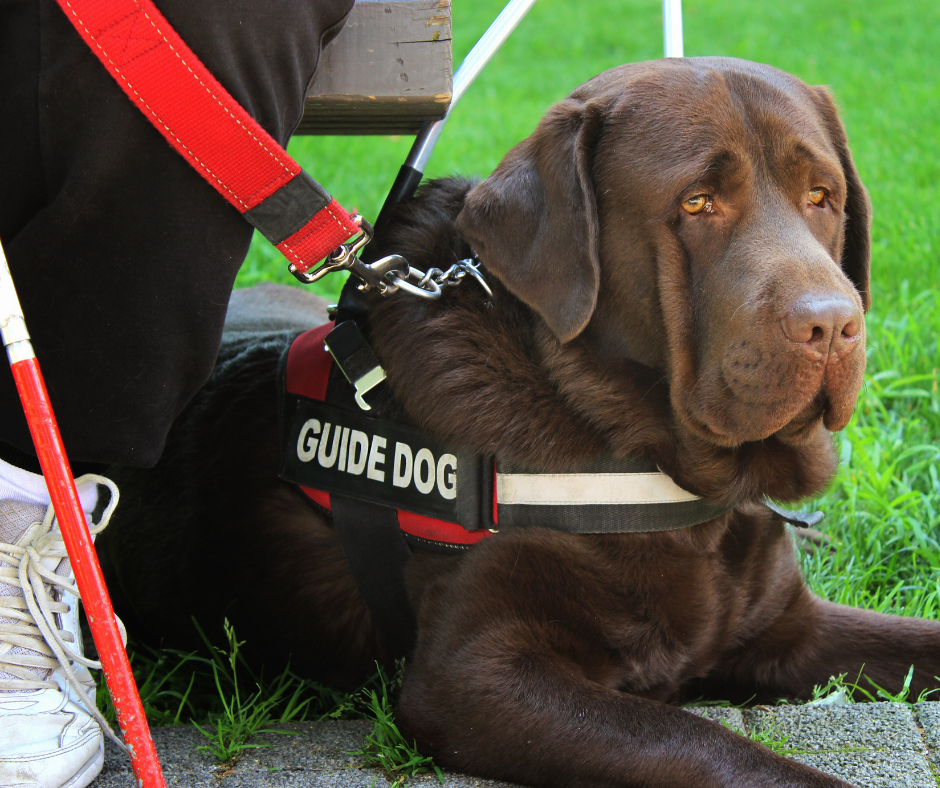
September 1, 2021
Are you or someone you know considering a guide dog? A guide dog is specially trained to lead a person who is blind or visually impaired (BVI) and help them move freely throughout their environment, alerting them to any obstacles along the way. Utilizing a guide dog is a big undertaking in comparison to the traditional white cane that most BVI use, so Clovernook Center has compiled a list of things to consider before making this life-changing decision.
Before we begin… It’s also important to note that the desire to use a guide dog is a very personal choice, and only the blind person can decide if it is the right choice for him/her.
- Encountering Obstacles: One of the main differences between a cane and a guide dog comes with encountering obstacles. Guide dogs are trained to avoid them; the dog chooses the best/safest pathway along the route. Cane users are accustomed to finding obstacles with their cane and then deciding which course is best to navigate safely around these barriers.
- Orientation and Mobility: It’s important for the person to have good orientation and mobility skills. They should be able to keep track of where they are, know the direction in which they’re heading, and be able to safely cross streets by listening to the flow of traffic. Because of this, it’s vital to critically consider the handler’s skills before making the choice between the two. The person should be able to travel independently to several different destinations.
- Level of Vision: A person does not need to be completely blind to benefit from using a guide dog. In fact, the majority of guide dog handlers do have some degree of usable vision. The important thing to remember is to trust the dog and not rely completely on that vision.
- Commitment: A guide dog’s basic needs can require a good deal of time and planning. The dog will need to be kept on a regular feeding and relieving schedule. The dog will need to work on a daily basis, in addition to having other outlets for exercise and playtime. Depending on the breed, a guide dog will most likely need to be groomed by its handler every day and may need to be professionally groomed several times a year. A guide dog is more than a tool. They will become a member of your family that desires praise, love, and attention.
- Budget: Having a guide dog can be quite costly and you will need to budget their expenses into your lifestyle. Guide dogs need to eat high-quality food, play with strong durable toys, and need quality grooming supplies. They also need regular veterinary appointments for health checks, flea/tick medication, heartworm preventatives, and vaccines. Keep in mind that accidents and veterinary emergencies can happen at any time and can be quite expensive.
- More Attention from Others: It’s inevitable that having a guide dog will draw more attention to you while out in public. This can simultaneously be both a positive and negative thing. For someone who is blind or visually impaired, a guide dog opens the door to interactions. People generally love to talk about dogs, so their handlers tend to meet, interact, and socialize with more people. On the other hand, it may cause unwanted distractions like small children who can’t help themselves and attempt to interact with the dog.
All in all, the decision to train with a guide dog is easy for some, but not as feasible for others. Having a guide dog should enhance the handler’s life, not hold them back. The decision should not be taken lightly, as a guide dog is not ideal for every BVI person. For many though, the benefits far outweigh the negatives. A guide dog can definitely enhance the independence and freedom of its handler. The dog offers constant companionship and the security of never having to navigate through the world alone.
Stay tuned this month as Clovernook Center celebrates National Guide Dog Month to raise awareness, appreciation, and support for guide dogs in our community. Did you miss our guide dog series last year? Click here to hear from Mambo, the guide dog, about his role as a service animal.
Back to News